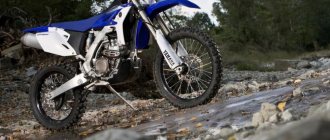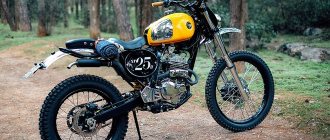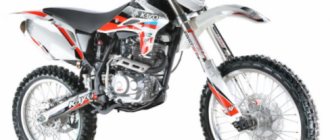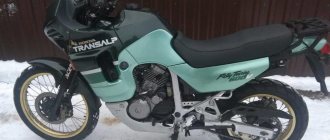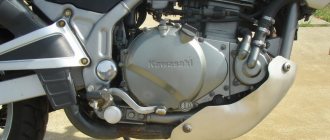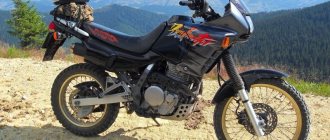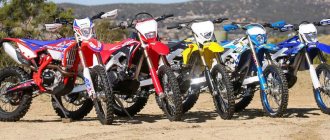Motorcycle Yamaha WR250R
Conquer any trail with the Yamaha WR250 R! The WR250R motorcycle is a direct descendant of the YZ and WR models. It is capable of delivering true pleasure to its owner both while traveling along an off-the-beaten path and while walking along city streets. Before you is a representative of a new generation of dual-purpose machines with unsurpassed technical characteristics. Based on the design of the legendary WR series, the Yamaha WR250R motorcycle has become a machine that performs perfectly both on smooth roads and off-road. Discover its 250cc fuel-injected engine, capable of delivering incredible power! The 2010 Revolution WR250R is capable of tackling the twistiest and most challenging trails. With its power, functionality and style, it is capable of winning the heart of any biker. The high-tech DOHC fuel-injected 4-valve engine produces more power than imaginable, breaking all the 250cc stereotypes, while the dual aluminum frame puts the driver in total control. Every part of the bike, from the titanium intake valves to the aluminum frame or swingarm, has transformed the WR into a heavy-duty dual-purpose sporting weapon. Thus, Yamaha breathed new life into the class of dual-purpose sports motorcycles with a 250 cm3 engine. Whether you're hitting the city streets or exploring your favorite trails, your Yamaha WR will be your reliable companion.
Peculiarities
- Dual purpose motorcycle
- 4-stroke single-cylinder engine with speed up to 10,000 rpm
- YZ-F motocross technology
- Titanium intake valves
- Fuel injection
- Aluminum main frame
Color options: blue . Technical specifications:
| Characteristic | Meaning |
| Engine | |
| engine's type | Four-stroke, single-cylinder, four-valve, DOHC |
| Cooling system | Liquid |
| Volume | 250 cc cm |
| Bore x stroke | 77.0 x 53.6 mm |
| Compression ratio | 11.8 : 1 |
| Maximum power | 22.6 kW (30.7 hp) at 10,000 rpm |
| Maximum torque | 23.7 Nm (2.42 kgf-m) at 8000 rpm |
| Lubrication system | Oil in the crankcase |
| Fuel supply | Electronic fuel injection |
| Clutch type | Wet type, multi-disc with coil spring |
| Ignition system | Transistorized ignition system TCI |
| Starting system | Electric starter |
| Transmission system | Constant mesh 6-speed |
| type of drive | Chain |
| Fuel tank capacity | 7.6 l |
| Oil system capacity | 1.5 l |
| Frame | |
| Frame | Semi-double frame |
| Front suspension | Telescopic forks |
| Front suspension travel | 270 mm |
| Rear suspension | Pendulum arm |
| Rear suspension travel | 270 mm |
| Fork angle | 26 |
| Clearance | 125 mm |
| Front brake | Single disc, 250 mm |
| Rear brake | Single disc, 230 mm |
| Front tire size | 80/100 R21M/C 51Р |
| Rear tire size | 120/80 R18M/C 62Р |
| dimensions | |
| Length | 2180 mm |
| Width | 810 mm |
| Height | 1230 mm |
| Seat height | 930 mm |
| Wheelbase | 1420 mm |
| Minimum ground clearance | 300 mm |
| Mass with technical liquids | 134 kg |
747500 rub.
Order Buy on credit
" Return
Yamaha WR250R: Test drive
A 250cc motorcycle? Yes, there are now plenty of such “wimps”! They were produced (and continue to be produced) not only by leading motorcycle manufacturers, but also by numerous Asian companies. Would normal motorcyclists really covet these products, which only from a distance resemble a motorcycle, but upon closer examination look like a toy for a couple of days? The concept of such models was initially distorted (for the sake of cheaper prices, of course, and therefore accessibility) and replicated in such quantities that only professionals are now able to separate flies from cutlets. Indeed, in addition to this avant-garde clone, which is constantly replenished with Chinese “recruits,” there were also quite mature-looking, tenacious and practical domestic Japanese 250 cc models such as Suzuki Djebel 250 , Yamaha TT-R250 Raid and Honda XR250 Baja . They came to us exclusively as second-hand goods and, of course, could not compete with much more affordable and mass-produced products from Chinese and Korean companies. And the source of used equipment is not endless. After all, the models are no longer produced. In recent years, it has become almost impossible to find them in good condition.
We must pay tribute to the Yamaha designers - they were the first (perhaps because the company’s marketers always had their finger on the pulse of the European and Russian markets) to sense the crisis of the situation and decided to release a model in the spirit of those ancient “jebels”, “raids” and “accordions” . But the debut of the WR250R was not as successful and loud as we would have liked. This is due to the fact that the name of the model echoed the company’s cross-country racing machine WR250F. Only after a couple of months did the consumer realize the beauty of Yamaha's new offering - and then overnight the model became a world bestseller. Despite the similarity of the indices in the name with the WR250F, the newcomer WR250R is a completely original development. Taking all the best from the iconic small-capacity enduro like the Yamaha TT-R Raid, the designers endowed the new product with a full set of necessary equipment for riding on public roads, as well as off them. It has a similar frame design and general layout in common with a cross bike. Yes, the pendants have become more utilitarian, and there is an increase in weight. But in the stock configuration, the endurist receives an electric starter, a full set of lighting equipment and a modern engine with an injector! And don’t forget the fact that enduro ergonomics are much more comfortable than cross bikes. Well, in external terms, the WR250R cannot be compared with the archaic Yamaha TT-R Raid and the like. Athletically fit, muscular, solid and at the same time compact! Personally, I have always been partial to such enduros. Therefore, I decided to get acquainted with the new product not by studying branded press releases and discussions on the topic, but through a full test drive. Fortunately, the Russian representative office of Yamaha specifically keeps this model in its “stable” for such purposes. A synonym for the term “enduro” is dual-purpose, i.e. equally practical in different elements, on and off the road.
The program of my tests clearly fit into this concept: first my path lay through city traffic, then along a country highway, and then along country roads to a kind of natural testing ground - a kind of imitation of cross-country potholes. I admit, in the capital’s crowd on the WR250R, at first I felt uncomfortable. This “quarter” seemed too thin and sharp. Where I used to drive on my Yamaha TDM900 with caution, for fear of catching the sides and mirrors on the sides of cars, this shooter flew like a ball into an empty goal. Accustomed to the fact that motorcycles of this cubic capacity are rather lazy on the gas, especially at low revs, at first I almost hurt myself when accelerating. Wow, it pulls as well as a 400cc enduro! Where so much agility comes from in a 250 cc “pot” remains a mystery to me. Especially after breaking into operational space, I managed to rev it up to a fantastic 155 km/h on the speedometer! Moreover, in such modes he behaved quite steadily. Even the braking potential was enough for effective decelerations.
The engine, by the way, was equipped with a new injection system. The accuracy of the injector’s operation is felt at speeds close to idle - you can leisurely “puff” in second gear almost at walking speed - the engine does not jerk or choke from a lack of combustible mixture. However, with all this, the suspension settings, tire tread pattern, and engine characteristics are still not for the asphalt jungle. Even after an hour's drive around the metropolis, my initial feelings of some uncertainty did not disappear. Over time, of course, you get used to everything, but I would not advise a potential buyer of this WR250 to buy the device exclusively for city driving. In addition, the company also has a purely asphalt modification of the WR250X model. But if at least 50% of your possible movements are on dirt roads and off-road, then the WR250R is what you need! I was convinced of this as soon as the wheels touched the broken surfaces of suburban areas. The energy-intensive suspensions, which are excessive for the city, immediately showed their strengths, swallowing seams and holes in the asphalt with unshakable confidence and without compromising comfort. The cruising speed is about 130 km/h according to the speedometer, so you don’t feel handicapped on open highways, although it’s better not to meddle in the left lane. Well, it’s good for us on the right, fortunately there is an opportunity to quickly spot some picturesque country road. The WR250R is asking for it – I’d like to go there!
This is the idyll of an endurist - the ground mixed with sand and rolled by cars, hillocks for jumping, gentle turns and so on until the horizon. Throwing a stream of soil from under the rear wheel, the WR250R smartly rushed forward. The cross-country roots immediately made themselves felt - the chassis, “twisting and straining,” firmly held the trajectory. Eh, I wish I could lower the center of gravity a little! What’s surprising is that the suspensions (in the front, by the way, are “upside-down”!) when jumping, survived the landings and never even worked all the way. And this despite the fact that my weight (just over 90 kg) is not at all suitable for such sports pleasures. Carried away by the drive, at one point I clearly overestimated my level of proficiency in this kind of equipment, which immediately led to a beautiful flight into the roadside bushes. The WR250R, as if in slow motion, continued to loosen the soil along the trajectory of the initial movement. While the clouds of dust were clearing, sad thoughts of evacuating the broken bike flew through my head and the damage calculation counter automatically started spinning. I took it for a ride... Well, what do you think - the motorcycle survived a fairly heavy fall from a speed of 80 km/h! Even the gearshift foot remained intact. Yes, the steering wheel was slightly bent and a crack appeared on the side plastic lining - but this is nothing at all, considering the nature of the fall. Continuing my journey, but at a more relaxed pace, I tried to analyze the reason for the unplanned landing and finally came to the conclusion that it was the universal tires. We must pay tribute to the designers, who very skillfully positioned all the vital components, from the air intakes to the muffler - damaging them when falling... you have to try!
It overcomes mud baths and even fords no worse than its cross-country counterparts. You can’t complain about the lack of power even in a swamp chacha. And if you plant it on the rear pendulum, you will definitely pull it out with your hands. Surprisingly, the braking systems also work perfectly in such inhuman conditions. As a result, I came to an unexpected conclusion - I would like to scold the motorcycle for something, but in reality there’s nothing at all. Miracles…
Odes of praise to some “quarter”, the reader will say. We know, we know... Everything here is paid for. It will be for you! Of course, I would really like to have such a motorcycle in my garage, but only as a second one - for fun in nature, for rides around the dacha, for going out with friends on all sorts of non-professional trophy raids. Because it’s clearly not suitable for every day. And I’m not going to change my TDM900 yet. Well, I can really understand those who are preparing finances to buy a WR250R. Judge for yourself: the device is quite budget-friendly - 280,000 rubles. for a new enduro with a guarantee and the best service in the country. Its performance is on par with its 400cc siblings, such as the Suzuki DR-Z400 , for example. By removing any “plugs” and limiters, you can easily “recharge” the motorcycle. Well, with the choice of competent tires, the issue of its ideal use for off-road rides is resolved. So my enthusiasm has a basis. With the advent of the WR250R, Yamaha showed everyone that the usual boundaries of the 250cc enduro class could be radically expanded.
Go to motorcycle Yamaha WR 250 (R, X, F)
- Read review Yamaha WR 250 (R, X, F)
